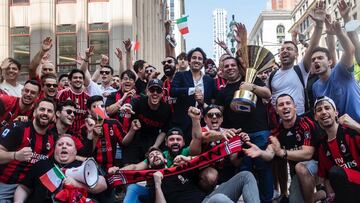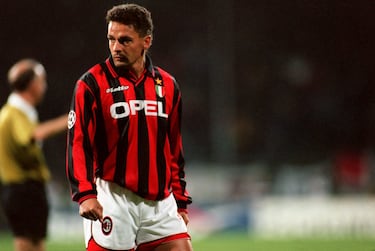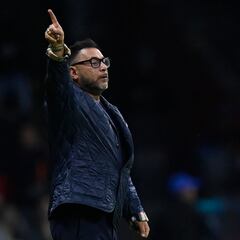NYC’s AC Milan fanatics show the changing face of US soccer
The game is growing across the United States and membership of the AC Milan Club New York City is booming.


“There weren’t many kids at school that used to follow soccer the way I did. I’d wear the jerseys to school and people didn’t even know what it was. I would wear my AC Milan jersey and they would be like ‘What’s OPEL?’”
Life-long AC Milan fan Franco was born in 1982, in the dying days of the United States’ first national soccer league, NASL. Soccer in America was floundering but Franco and his Italian-born father were transfixed by a new super-team rising to dominant Europe. The AC Milan side of the late 1980s and early 1990s is often cited as one of the game’s finest and the success of those glory years was a formative experience for Franco.
AC Milan were one of the biggest and most illustrious teams in European soccer but keeping up to date with their successes was not easy. He cherished whatever magazines, newspapers and television footage he could find, taking advantage of a public access network that carried the occasional burst of Italian programming.
“On Sundays they would show the prior week’s La Domenica Sportiva, a highlights show, early in the morning. And then they would go live to one stadium and show one game, usually the most interesting match of the week. That game would be at 8:30 in the morning so every Sunday we’d wake up early, watch soccer and then go to church.”

Three decades on Franco’s bond with AC Milan is just as passionate. The means, however, of expressing that passion have changed. He is one of the leaders of AC Milan Club New York City, a supporters’ group aiming to bring a taste of the famous San Siro to the heart of Manhattan. Now, Franco tells AS USA, is a boom time for soccer fans in the US.
Italian giants wake from slumber
AC Milan Club New York City has its origins in 2008, when a group called the Milan Club of New Jersey was formed. In those early days the group was a more insular affair with a close-knit band of Milan fans meeting each week to drink coffee and talk calcio.
Initially it was more of a ‘private members club’ affair but a handful of new members began to shift the group’s focus, holding watch parties in New York City and spreading the word on social media. It was on Twitter that Franco first found the group in 2011. He went along to watch a game and was stunned by the thriving, Italian-American soccer culture he discovered. He quickly became an organiser and was a part of the splinter group that relocated to Manhattan’s Football Factory sports bar and took on its current name, AC Milan Club New York City.
Franco explains: “From there the club grew and grew and grew in popularity. Even in the darkest of years around 2014-15 and 2015-16 we were able to establish a presence and still grew. So then when the team started getting better, then we really had a big growth in popularity.”
L’amore per questi colori non conosce confini. Da Milano a Manhattan, #sempreMilan. 🔴⚫️🗽 #ForzaMilan #ACMilan #milanisti #curvasudmilano #rossoneri @FFactoryNY pic.twitter.com/TL2ePnZPzy
— AC Milan Club New York City (@ACMilanNYC) January 25, 2024
Everyone wants to follow a successful team and AC Milan’s recent resurgence has brought new support to the NYC fan club. In 2021/22 Stefano Pioli’s side won the Italian championship for the first time in a decade and they reached the semi-finals of the Champions League the following year. Last summer the arrival of USMNT star Christian Pulisic made them the ‘second team’ of many American fans, a US representative in elite European soccer.
A real taste of Italy
The NYC fan group replicates the customs, the colours and the chants of San Siro for a broad spectrum of soccer fans. There are the fanatics like Franco, raised from birth to follow the fortunes of AC Milan. There are Italian-Americans who feel a particular connection Italian soccer. There is a rotating cast of Italian transplants who drop in while studying abroad or vacationing in the city. But a significant proportion - including two committee members - have no Italian links whatsoever. That mixture, it transpires, creates a pretty special atmosphere.
Franco explains: “When visitors come from Italy they’re expecting to find a bar full of Americans, who maybe know about Milan but not really. And then the first chant erupts and they look around the bar and see everyone singing, whether or not they speak Italian. At the end of the game more often than not they’re the ones that come up to us and say ‘You have something really special here’.”
Sometimes those visitors are pretty special. Legendary Milan defender Franco Baresi, winner of three Champions Leagues and six Italian championships, has made an appearance. So has former star Daniele Massaro. And when AC Milan president Paolo Scaroni was in town to give a speech at the United Nations he made sure to spend an evening with AC Milan Club New York City.
The single greatest night in the history of this club. Thank you to @FBaresi, @acmilan, @FFactoryNY, Fondazione Milan, and TOPSoccer for an incredible evening. Full album on our Facebook page! #ForzaMilan #ACMilan #NYC #Baresi -faz pic.twitter.com/yCQpa4OB2W
— AC Milan Club New York City (@ACMilanNYC) July 24, 2019
Former Milan midfielder Sandro Tonali, now at Newcastle United, once dropped by with his girlfriend and ended up spending an hour and a half chatting with supporters. Two days later Franco received a message from Tonali’s girlfriend on his behalf, inviting him and other committee members to have dinner with him that night. From their distant outpost on the other side of the Atlantic, members of AC Milan Club New York City can rightly feel like true Milanese.
The changing face of US soccer
In the past decade the group has gone from strength to strength. The dispersion of soccer into America’s sporting consciousness continues to bring new fans to the game and AC Milan, restored to the top table of European soccer and boasting the USMNT captain, are well-placed to benefit from the boom. The United States will host this year’s Copa America and the 2026 World Cup. The domestic league is growing in quality and American players are finding greater success overseas. Soccer’s growth appears inevitable and the AC Milan Club New York City has an important role to play.
“When I was a kid I thought going to San Siro would be impossible. Fortunately, I got to go there but for some people it’s still a very far-away possibility. But people can walk into the bar and be able to sing the chants that they see on social media, to be together with other people, to jump around like a maniac and cheer for their team. It’s about sharing the love of red and black.”
Related stories
Franco, now 41, describes his life as “a timeline of soccer” in the United States. He spent his childhood as a rare soccer obsessive; wearing his Milan jersey to school and savouring the Sunday morning calcio with his father. Now he part of a thriving soccer community in the US’ largest city, spreading the gospel of AC Milan and the game more broadly. And, through his day job, he can see exactly how much has changed.
“I’m a teacher and the amount of kits that you see being worn by kids in school - various clubs from around the world - is incredible. It’s night and day from when I was their age and a great gauge of where soccer is now. The other day I heard a kid in the corridor talking about Joshua Zhirkzee, the Bologna striker. I turned around to see this average American kid standing there. I was like ‘You’re talking about Bologna? That’s sick.’”


Complete your personal details to comment